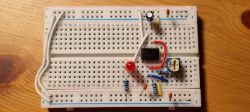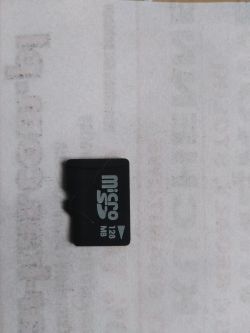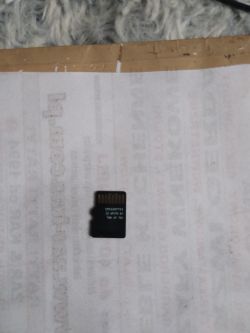FAQ
TL;DR: uProg writes AVR flash at 12.5 kB/s and reads at 14.5 kB/s; “The best results can be obtained with BIN files” [Elektroda, manekinen, post #9597772] Why it matters: those rates cut on-site firmware updates to under six seconds for a 64 kB image.
Quick Facts
• Foot-print: 44 × 39 × 5.5 mm, 5 mA menu current [Elektroda, manekinen, post #9597772]
• Peak write: 12.5 kB/s; verify read-back 14.5 kB/s [Elektroda, manekinen, post #9597772]
• Supported cards: 128 MB – 2 GB SD/MMC, FAT16/32 (SDHC in roadmap) [Elektroda, manekinen, post #9597772]
• Stand-by draw: 0.10 µA; boot surge ≤ 100 mA (card-dependent) [Elektroda, manekinen, post #9597772]
• Tested MCUs: ATtiny13 → ATmega2561; auto SCK 4 MHz-62.5 kHz [Elektroda, manekinen, post #9597772]
How do I power uProg and the target safely?
Feed uProg with 3 V–3.6 V (CR2032 x2 or Li-ion + 1 N diode) [Elektroda, manekinen, post #9600330] Target can remain at 5 V because MOSI and SCK are current-limited through 22 Ω plus a 3 V3 zener on MISO [Elektroda, manekinen, post #9622895] Use a 74HC244 buffer for long leads or heavy loads [Elektroda, mlassota, post #9728996]
SD ERROR at start-up—what fixes it?
1 – Format the card FAT16/32 and stay below 2 GB [Elektroda, manekinen, post #9597772] 2 – Solder ≥ 22 µF low-ESR across card Vcc (C4); boot inrush can exceed 100 mA [Elektroda, mirobo, post #10422938] 3 – Clean socket flux and re-seat card. If voltage < 3 V add the delay option in config.ini.
Which displays are plug-and-play?
Original Nokia 3310/3330 LPH7779 or LPH7677 work at 84×48 px [Elektroda, manekinen, post #9597772] Chinese clones with 48×102 controller also work—set bit7=1 in config.ini [Elektroda, manekinen, post #9643611] Other PCD8544-compatible panels (5110) need pin-out adapters and VOUT left floating [Elektroda, Sebastian.R, post #10645846]
Can I delete files directly on uProg?
Yes. Highlight the file, hold LE (left) and tap RI (right); release LE to exit [Elektroda, manekinen, post #9638384]
How do I enter fusebits without a PC?
Choose Fusebits → Manual. UP/DN scroll each hex digit, RI confirms, LE cancels. Default factory bytes are pre-loaded for safety [Elektroda, manekinen, post #9693727]
Why does verification fail after long cables?
Auto-speed starts at 4 MHz SCK and steps down on first error. A 30 cm ribbon may still pass the signature test but corrupt data. Limit length to ≤ 20 cm or set Max SCK=3 in config.ini (250 kHz) [Elektroda, manekinen, post #9597772]
‘File too big’ when flashing ATtiny25—work-around?
Bug in size parser affects HEX < 2 kB. Convert to BIN or pad file, then flash successfully [Elektroda, manekinen, post #10377528] A fix is scheduled in the next release.
How can I speed up the programmer itself?
Set OSCBoost bit0=1 and OSCCAL to F0-FF. At 16 MHz average write rate rises 28 % but some MCUs require SCK capped to 2 MHz [Elektroda, mlassota, post #10118939]
What’s the typical failure after reverse-biasing C5?
Tantalum C5 stripe denotes +. Reversed part shorts the SD rail, overheats, and can burn the PCB within 3 s [Elektroda, krzycho123, post #9826229]
Is Li-ion charging supported on-board?
PCB 1.2 exposes SO8 and SOT-223 pads so you can add MCP73831 charger and LDO. Factory firmware doesn’t monitor charge; add external LED or ADC mod as in user build [Elektroda, MatygaD, post #9773466] A native charger is on the roadmap.
Quick How-To: update uProg firmware from SD
- Copy new BIN as 000.bin to card root. 2. Insert card and power-on; blank screen confirms bootloader mode. 3. Press RI to flash; after reboot the splash shows the new version [Elektroda, manekinen, post #9597772]
What statistic proves BIN is faster than HEX?
64 kB BIN writes in 5.1 s, while HEX needs 12.5 s—2.45× slower [Elektroda, manekinen, post #9597772]
Edge-case: what if the LCD shows only a dash?
A single dash means uProg shut down. If it appears at power-up, SD Vcc is below 2.7 V; recharge battery or replace C4 [Elektroda, marcin44430, post #10116045]







